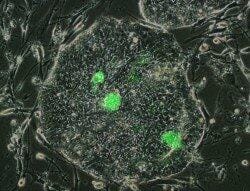A New Method to Perpetuate Human Stem Cell Cultures

An international team of researchers from several institutions led by the University of Bath have developed a new method to detect and preserve human stem cells in culture. The new technique keeps active a genetic sequence that is always found active in naive stem cells. The study was published in the journal Nature Protocols.
Naive embryonic stem cells have great potential for therapeutic applications: these cells can become any cell type and could be used in cell therapy, in drug tests or to understand the molecular mechanisms happening inside organs. In mice, stem cells are easily derived from blastocysts. However, it has not been possible to do the same in humans, where these cells are very difficult to acquire and cultivate. For this reason, human stem cells are artificially generated by modifying the culture conditions or the genetic makeup of the cell.
Tagging the HERVH endogenous retrovirus
The researchers, led by Zsuzsanna Izsvák and Laurence Hurst, developed a new method to detect and culture human stem cells. These cells quickly lose pluripotency after being separated from the embryo, but the authors show that, in human embryonic stem cell (hESC) and human induced pluripotent stem cell (hiPSC) cultures, there is a small percentage of cells (less than 5%) that maintain a naive state. In a previous study, the scientists discovered that the HERVH sequence is always active in naive stem cells. Now, they have tagged with green fluorescent protein (GFP) a HERVH endogenous retrovirus. With this protocol, hESCs and hiPSCs can be identified, selected and maintained in six weeks. The genetic expression profile of the HERVH expressing cells is variegated, suggesting that several pluripotent states might exist.
Source: U. of Bath

